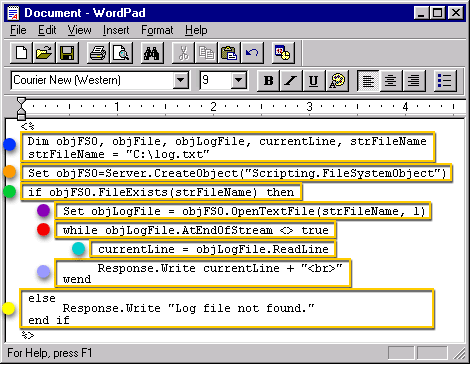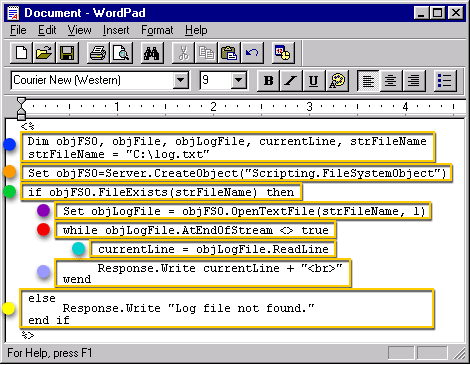| Lesson 8 | Reading and outputting files |
| Objective | Use the FileSystemObject object to read and output a file. |
Reading and outputting Files in ASP
Once a text file has been created, it's very useful to be able to access it through an ASP script. This technique is often used to import large amounts of data into the application. Reading a text file also involves using the FileSystemObject object,
which has an OpenTextFile method. The OpenTextFile method has these parts:
- Object: (Required) Always the name of a FileSystemObject.
- Filename: (Required) String expression that identifies the file to open.
- Iomode: (Optional) Indicates input/output mode. Can be one of three constants,: ForReading (1), ForAppending (8), or (2) ForReading, which is the default.
- Create: (Optional) Boolean value that indicates whether a new file can be created if the specified filename doesn't exist (True to create the file, False not to create one). The default is False.
- Format: (Optional) If omitted, the file is opened as ASCII.
<%
Dim objFSO, objFile, objLogFile, currentLine, strFileName
strFileName = "C:\log.txt"
Set objFSO=Server.CreateObject("Scripting.FileSystemObject")
if objFSO.FileExists(strFileName) then
Set objLogFile = objFSO.OpenTextFile(strFileName, 1)
while objLogFile.AtEndOfStream <> true
currentLine = objLogFile.ReadLine
Response.Write currentLine + "<br>"
wend
else
Response.Write "Log file not found."
end if
%>
Here is the same code segment with an explanation:

Write to File using ASP

- Declares variables needed to handle the file information. Assigns the name of the file to the strFileName variable
- Creates an instance of the File System Objects and assigns a reference to objFS0
- This statement verifies that the file exists. if it does not, a message should be displayed to the user
- Opens the text file in strFileName for reading, defined by the constant 1(2=write, 8 = append) Assigns a handle for the file to objLogFile
- While loop will continue executing until the End of File is encountered
- Reads a line from the text file and assigns it to current line . Information is read as a string.
- Appends a line break to the currentLine
- Message to be displayed if the file is not found.
Set objLogFile = NothingSet objFSO = Nothing